HTC Thunderbolt Review: The First Verizon 4G LTE Smartphone
by Brian Klug on April 27, 2011 12:12 AM EST- Posted in
- Smartphones
- HTC
- Verizon
- LTE
- 4G
- Android
- HTC Thunderbolt
- Mobile
- MDM9600
- MSM8655
The rear of the Thunderbolt is divided in two. The top battery cover area is coated with HTC’s favorite black soft touch material, and down below is a beefy kickstand that seems at least twice as wide as the EVO’s. Underneath the kickstand is the Thunderbolt’s speakerphone grille.
Further down is a small rubber plug dead center in the back of the phone. If you can manage to wry it loose, underneath is what looks like a test port for the CDMA RF path rather than an external antenna connector. It’s difficult to get out, and even more difficult to get back in straight.
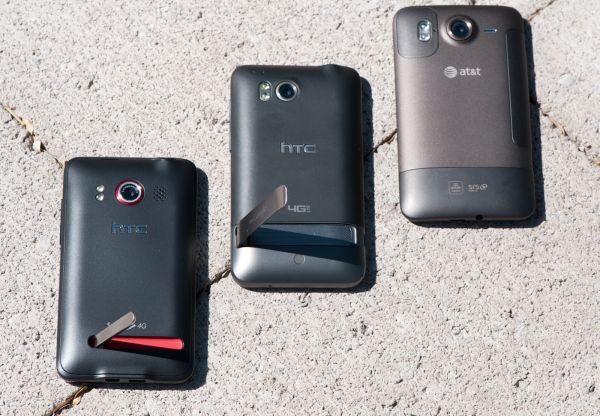 Kickstands (Left to Right): HTC EVO, HTC Thunderbolt, HTC Inspire
Kickstands (Left to Right): HTC EVO, HTC Thunderbolt, HTC Inspire
The kickstand seems to be something HTC always does on its absolute latest and greatest, and clearly alludes to HTC’s other 4G first with WiMAX. The EVO and Thunderbolt both have kickstands, though I have to admit that I like the Thunderbolt’s better. It works in landscape and portrait, though landscape is clearly the intended orientation. It’s bigger and beefier, and feels more secure in both orientations than the EVO’s does as a result.
My only complaint is that there’s some sort of coating material on the kickstand metal which has begun chipping off, making a weird discolored pattern right where the kickstand contacts the surface it rests on. Likewise, on the rear where it is coplanar with surfaces, it has begun chipping off. I’m not abusive with my own devices (nor review units), it’s just seriously peeling off.
The design language of the Thunderbolt is clearly inspired by the HTC Desire HD (and its AT&T variant, the Inspire 4G, which I picked up for personal use). Side by side, it’s obvious that these two share a ton of industrial design notes.
The recessed chrome earpiece grille with notification LED below, button schema, and edge curvature radius is all the same. I can see how the recessed notification LED could be a huge pain. Green is a bit hard to see, orange for charging seems much easier. To me this looks about the same between the Desire HD and Thunderbolt.
Where the two differ most notably is construction. The Desire HD is primarily metal of the same sort the Nexus One came clad in, HTC’s favorite purple/grey material. Unlike its cousin, the Thunderbolt is almost entirely plastic, though the rough matte polish of the device cleverly disguises this concession. HTC is clearly marching in the direction of unibody metal phones, as evidenced by the Sensation/Pyramid.
So why plastic for the Thunderbolt? The reason might be RF, as the Deisre HD leverages the battery compartment door’s RF window to hide a WiFi antenna, and the SIM card slot at the bottom for cellular (as does the Sensation). The Thunderbolt can’t make any such concession, being literally stuffed full of antennas. Likewise, perhaps sheer size also necessitated plastic to keep mass reasonable. Either way, the Thunderbolt scuffs and deforms like plastic if you drop it, I’ve had it in my pocket long enough that I’ve dropped it twice already, creating such scuffs.
Button placement and responsiveness are totally fine. The power button is up at top and protrudes enough for easy location with the index finger when held in either hand. On the other side is the headset jack, and next to it is a noise cancellation microphone.
On the far right is the volume rocker which is adequately clicky. Subjectively, the Thunderbolt’s volume buttons seem far easier to manipulate than the Desire HD’s, whose buttons blend into the battery cover door and are far too smushy. (As an aside, HTC supposely knows about this problem and is redesigning the battery door and offering replacement doors if you’re an Inspire/Desire HD owner.)
The Thunderbolt’s microUSB port is on the bottom left of the device. The only thing on the far bottom of the phone is the microphone port.
Overall construction of the Thunderbolt is good, though I still think the Desire HD’s real metal unibody design is far more rugged. HTC industrial design seems to be headed squarely in the metal-unibody route if designs like the Sensation and others like the Desire S or Incredible 2 say anything. I’m definitely excited about those, going forward.
| Physical Comparison | ||||||
| Apple iPhone 4 | LG Optimus 2X | HTC EVO 4G | HTC Thunderbolt | |||
| Height | 115.2 mm (4.5") | 123.9 mm (4.87") | 121.9 mm (4.8") | 122 mm (4.8") | ||
| Width | 58.6 mm (2.31") | 63.2 mm (2.48") | 66.0 mm (2.6") | 67 mm (2.63") | ||
| Depth | 9.3 mm ( 0.37") | 10.9 mm (0.43") | 12.7 mm (0.5") | 13.2 mm (0.52") | ||
| Weight | 137 g (4.8 oz) | 139.0 grams (4.90 oz) | 170 g (6.0 oz) | 183.3 g (6.46 oz) | ||
| CPU | Apple A4 @ ~800MHz | NVIDIA Tegra 2 Dual-Core Cortex-A9 (AP20H) @ 1 GHz | 1 GHz QSD8650 65 nm Snapdragon | 1 GHz MSM8655 45 nm Snapdragon | ||
| GPU | PowerVR SGX 535 | ULP GeForce | Adreno 200 | Adreno 205 | ||
| RAM | 512MB LPDDR1 (?) | 512 MB LPDDR2 | 512 MB LPDDR1 | 768 MB LPDDR2 | ||
| NAND | 16GB or 32GB integrated | 8 GB integrated, up to 32 microSD | 1 GB integrated, 8 GB microSD preinstalled | 4 GB NAND with 32 GB microSD Class 4 preinstalled | ||
| Camera | 5MP with LED Flash + Front Facing Camera | 8 MP with autofocus, LED flash, 1080p24 video recording, 1.3 MP front facing | 8MP with dual LED Flash and 1 MP Front Facing camera | 8 MP with autofocus and dual LED flash, 720p30 video recording, 1.3 MP front facing | ||
| Screen | 3.5" 640 x 960 LED backlit LCD | 4” 800 x 480 IPS | 4.3” 800 x 480 LCD-TFT | 4.3” 800 x 480 LCD-TFT | ||
| Battery | Integrated 5.254Whr | Removable 5.6 Whr | Removable 5.5 Whr | Removable 5.18 Whr | ||
The Thunderbolt's packaging is a bit of a departure from the rest of the Verizon 4G LTE box artwork. It's a striking black affair with embossed Verizon and HTC lettering. The inside is blood red Verizon color. Inside is the phone with microSD card preinstalled, USB cable, charger, and manuals.
I've also put together a rather long video review of the HTC Thunderbolt with a demonstration of practically everything, though I'll link to pertinent parts throughout this review.


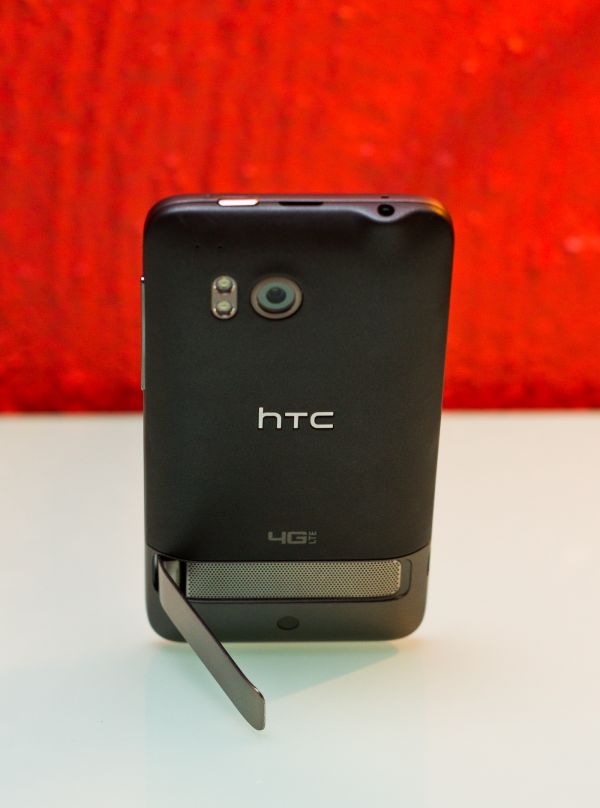
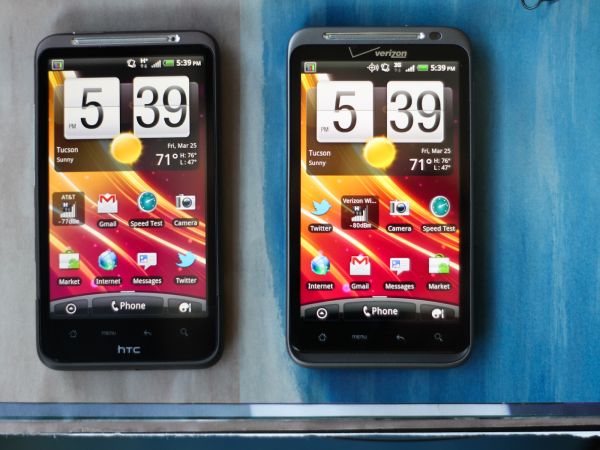
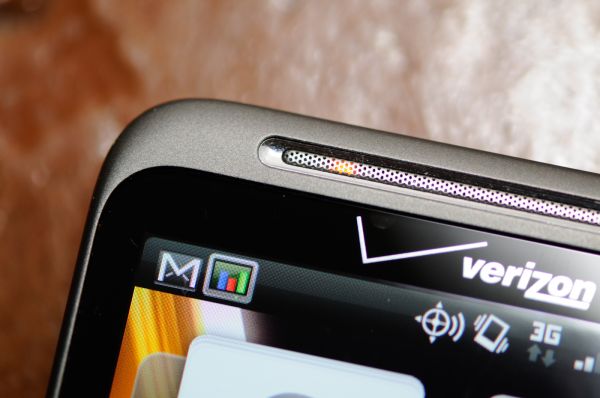

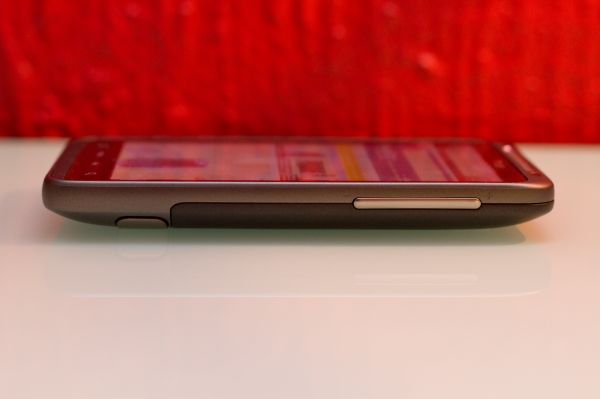
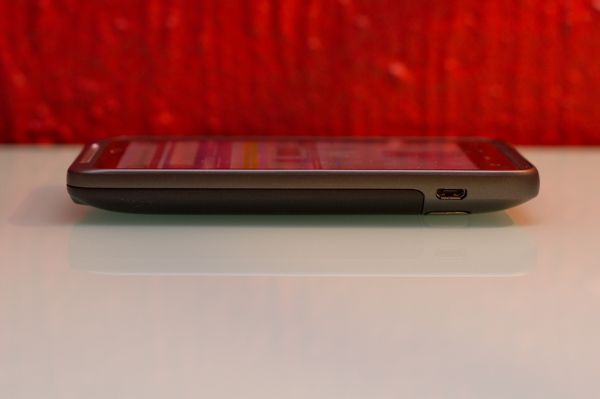
















71 Comments
View All Comments
Omid.M - Thursday, April 28, 2011 - link
A friend "in the know" (yeah, yeah) said HTC accidentally shipped it with S-ON for that portion of the internal storage, and that HTC had (has?) issued an OTA that will allow the full 8GB to be useable. Not sure if it's been pushed, as I don't have the Thunderbolt.Brian,
1) How quickly did GPS lock?
I feel like some of these issues that users experience with other phones---e.g. GPS lock on SGS phones---should be considered for reviews of future phones. I know it can be a hassle, but it should highlight that some issues are manufacturer specific. Hopefully, it lights a fire under mfrs. to correct these problems, if they see that other phones don't suffer from the same.
2) Also, maybe I missed it, but has AnandTech established a Light-Moderate-Heavy usage pattern for phones to test battery life?
i.e., Moderate = 45 min of Bluetooth, 20 min GPS navigation, 10 phone calls, 50 sms, 20 still pictures, etc ?
I saw you set display brightness to 50% and loaded web pages, but I'm talking about how a user would normally use the phone: calls, sms, pictures, BT, GPS...etc.
I am positive you guys have done it before.
Really amazing review. Have been spreading the word, hoping more people flock to AnandTech. You guys deserve the recognition!
@moids
Brian Klug - Thursday, April 28, 2011 - link
Moids,I haven't gotten any OTA updates, but that's entirely possible. Sometimes these review units get updates on a different schedule, so I have no idea. I should check whether it's S-ON or S-OFF.
I constantly forget to post about our GPS testing, possibly because I take it for granted these days that devices do it right. It's something I do test however with a bunch of phones at the same time and compare SNR for all the visible satellites using GPS-Test.
GPS locks fast, but not extremely fast. I took multiple road trips to Phoenix with the Thunderbolt doing navigation guidance. I'd say that 15 seconds with complete sky LOS is enough to get a lock. In location services it does have checkboxes for Verizon's location services and google's. I neglected to take screenshots but SNR is very good on the TB, no GPS problems here.
So the battery life test situation is continuing to evolve. We're working on and will have a system trace setup (exactly what you mention, GPS, using the phone, SMS, browsing) eventually. It's still in progress, of course it'd only work for Android comparisons at present.
Thanks for the good word as always ;)
-Brian
Omid.M - Thursday, April 28, 2011 - link
Feature requests:1) permalinking
2) Signature (with char. limit, like 40 chars, for Twitter ID,etc.)
3) Comment reply notification -- this one is HUGE. It's impossible for me to find replies to my comments, given then I can reply to an old comment (so my reply is "newer") but still buried in a sea of comments from older dates. Make sense?
4) Add Tapatalk compatibility to the AT forums. The mods said they're just waiting on Anand to approve, and I've given examples of other forums built on the same system (phpBB, etc) with equal or more users, to show that those forums are working fine and won't buckle under high traffic. Just have to register the forums (free) with Tapatalk so we can post using the Android/iOS app.
Oh, and a Wordpress style mobile version of these articles would be sweet, especially for commenting.
Come on, AT! The best tech site on the net should have these features! :D
Great work as always. Hope you nail those papers, Brian.
Omid.M - Thursday, April 28, 2011 - link
Awesome. Thanks for the reply!The OTA is coming if it hasn't already. I'll check with my source, but he said HTC definitely wanted to make the full 8 GB usable, so it was definitely a minor oversight on their part which they intend to correct.
I don't know why more manufacturers haven't built antennas into the cover. It definitely seems the way to go.
FYI,
Regarding the sig, if you could make it so the badge (to the left) has another bar below the handle where you can put, say, a Twitter ID...well, that'd be slick...hint hint.
That way, since it can only take something like a Twitter ID, you won't have to worry about junk URLs clogging up the comments section. Plus, people can retweet or tweet at individual comments.
Expect more RTs of this article shortly :)
whthawk - Friday, April 29, 2011 - link
Fascinating and easy read. Thanks!FITCamaro - Sunday, May 1, 2011 - link
I love all the people who are like "its thick and heavy....waaaa..." Man up people. Some of us like to have a phone that has some meat to it so we don't feel like we're going to break it. Nor is 5 ounces instead of 4 going to make any difference. For me even the Thunderbolt barely is noticeable when I'm holding it.floyd1 - Wednesday, May 4, 2011 - link
he folks who can tell me how can i order this htc thunderbolt???? and what is the price??? hope some one can help me my regards floyd from hollandname99 - Saturday, May 7, 2011 - link
"The Thunderbolt has noticeably less attenuation when held in a 4G LTE scenario, no doubt thanks in part to the fact that it's fully leveraging MIMO "This statement makes no sense.
(a) To know what is going on requires knowing what is being reported by that signal strength number. THE big issue with mobile radio is the VARIANCE in signal strength. This variance occurs on a timescale of 10s of ms, and a spatial scale of cm/
So when that dB number is reported, what EXACTLY is being reported? The maximum value over the past n seconds? The minimum value? A time average of the power, converted into dB? A time average of the dB rating. (Since the mapping from power to dB is non-linear, these two types of averages are VERY different),
(b) MIMO is NOT a technology to deal with a weak radio signal, in fact the exact opposite.
Given two antennas, you can use them in two DIFFERENT ways.
(i) You can use the two antennas via receive diversity, which means they each pick up an independent version of what is essentially the same signal. This is useful when the amount of signal variance means that one of the signals is frequently too weak to be useful, but usually not both, so at least one of the signals is strong enough to be useful.
ST codes like Alamouti are a fancy version of this idea.
Note --- this is useful for situation where the combination of the mean signal strength AND the variance means that the signal is sometimes too weak. It does not help if the mean strength is too low to be useful; it is a coping mechanism for a high variance.
(ii) MIMO is different. MIMO says we will use the two antennas to decode what are essentially two independent streams of data, and double our throughput. For this to work, we require that the lowest signal strength received (even in the presence of variance) not be too low. Thus this is a technology to take advantage of either a high mean signal strength, or an unusually low variance in the signal strength.
You can use your antennas to give you either diversity (more consistent reception) or MIMO (higher throughput, under good conditions), but not both.
NEITHER diversity nor MIMO can deal with a signal that is too weak. There IS multi-antenna technology that can do this (beam shaping) but I don't know if any carrier or cell-phones use this.
In other words, if this phone shows lower attenuation when being held
(a) who knows WTF that actually means, since we have no idea what is actually being measured
(b) it likely has more to do with the details of the placement and geometry of the antenna than with antenna diversity
(c) it certainly has nothing to do with the specific technology of MIMO
name99 - Saturday, May 7, 2011 - link
Having made the complaint above, congrats to Brian for taking my earlier complaints about these reviews to heart and trying to get a more comprehensive picture of the capabilities of these phones beyond mere headline numbers!Certainly, for example, the histograms are very helpful.
EvoGuy - Monday, May 16, 2011 - link
Droid Charge does not have an MDM9600 or any other Qualcomm IC.Of the four LTE smartphones coming to Verizon, only HTC has a Qualcomm LTE IC. CDMA is handled by VIA in the Charge, Q has the other three.
Also, EV-DO stands for EVolution-Data Only. "Data Optimized" is a backronym to try and cover up the fact that EV-DO cannot support voice. There was a standard called EV-DV (EVolution - Data & Voice), but it was killed by the giant IC company.